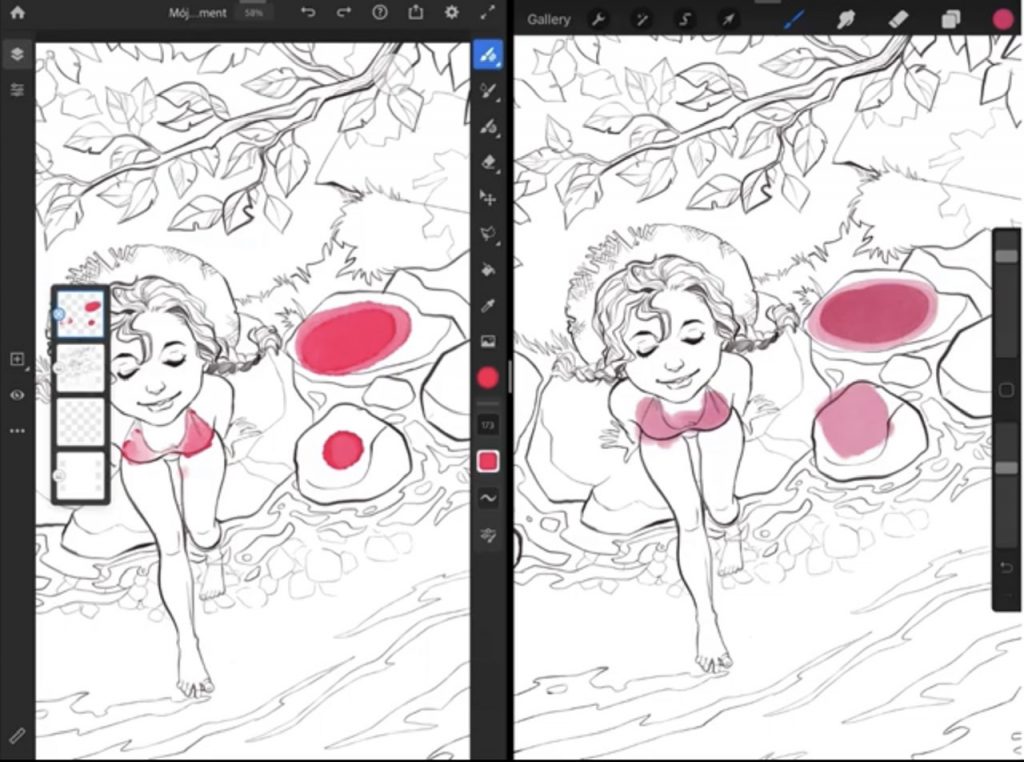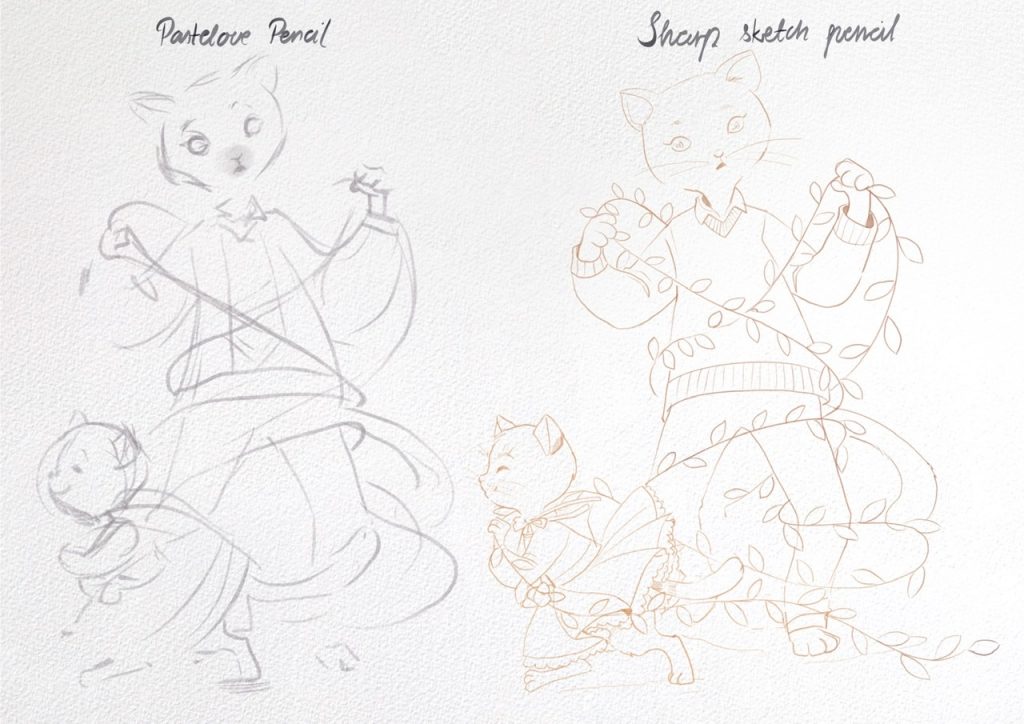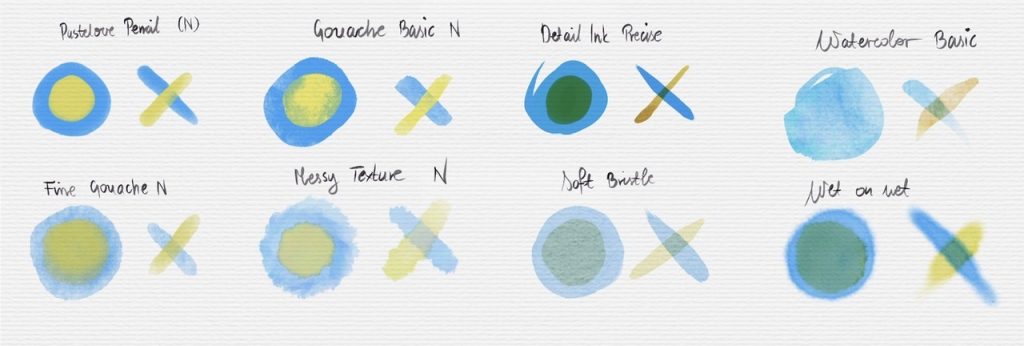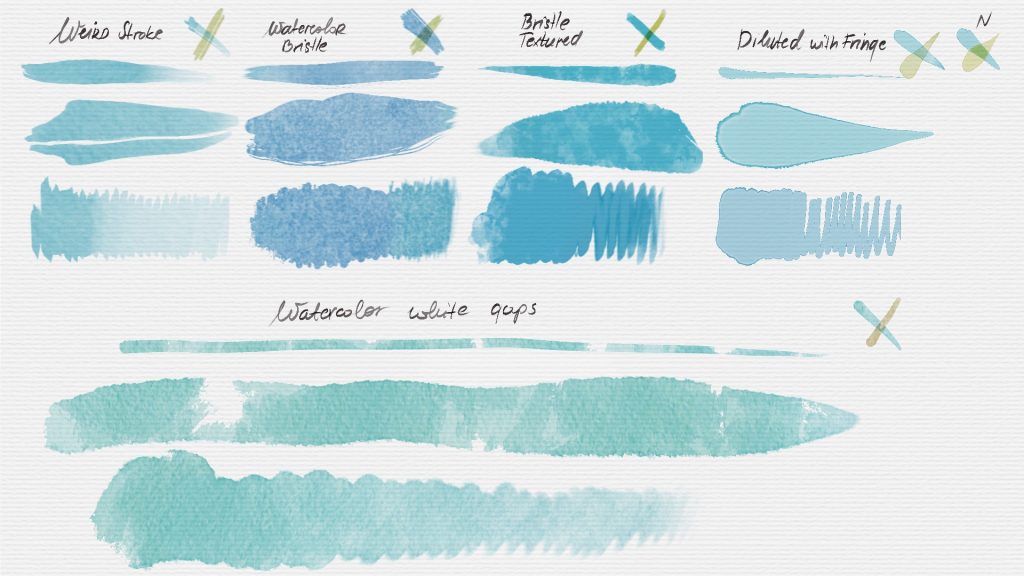Gouache Brush Paint Tool Sai
You probably know that I am a digital watercolor freak, so you won't be surprised. I created a watercolor brush set for Procreate. It took a while, but I am really proud of the result. In this post I wanted to tell you:
- why I needed to do it,
- why for Procreate,
- how they look like,
- what tasks I gave to specific brushes,
- how you can use them to create digital watercolors in Procreate.
I want to describe all of my brushes, but it would make the post too long. That is why I separated it into three parts. In this one, you will know more about:
- Sketching brushes.
- Ink brushes.
- Darkening edges brushes.
- Watercolor brushes for painting (and more).
Digital watercolor – searching for a perfect solution
By the way: my first steps with watercolors took place at the same time when I tried a digital art technique for the first time. Since then, my progress in both was simultaneous. But I guess that made me look for a watercolor, traditional look in digital illustration. It is one of my obsessions for sure!
Brushes, software, apps
I tried many, and I always look for new ones to try! In most cases, you can create digital watercolors if you know what effects you want to recreate. I liked a lot the soft brushes with fringe from old but still great Easy Paint Tool Sai. I loved how it mixes colors on canvas. There was a time when my first choice was a watercolor brush set for Photoshop by Kyle T. Webster. I am also a fan of watercolor brushes in Clip Studio Paint.
-
Easy Paint Tool SAI -
Adobe Fresco -
Clip Studio Paint -
Rebelle
When I found Rebelle, I thought that here my search ends. It is perfect! Watercolors there not only look like real ones, but they also behave as such! You can find more posts about Rebelle on my blog (Winter landscape in Rebelle, Rebelle 3 tutorial).
I guess I would never create my watercolor brush set for Procreate if I didn't buy an iPad in 2018. iPad was a revolution for me in many ways, although I had so many doubts before I bought it (I described it all in my most popular post – How and why I bought an iPad Pro).
I thought it is a very expensive digital sketchbook, but it is so much more. It replaced my computer at 99%, and it set me free from sitting by a desk for long hours.
Now I use my computer mostly for color corrections and saving works for publishing. For all the rest, I use my iPad. I replaced Photoshop with other apps without a problem. In comparison to this massive software, painting apps for iPad are much quicker, easier to use, with more intuitive interfaces and gestures the same (at least) quick and easy to use as keyboard shortcuts. These apps are still updated, and the main focus is to be a great painting app. I have an impression, that Photoshop is a way behind them, and there is nothing new for illustrators in the latest versions. You can find Photoshop or Fresco (an app dedicated to digital painting specifically) in the App Store, but I think they have to catch up with rivals and were left behind. Do you also feel this way? Or maybe you like them more than other apps – let me know!
I am under a great impression of Clip Studio Paint for iPad – it is almost the same software as a desktop version. A powerful tool! My biggest issue is the subscription payment. Not cheap at all (ca. $71.99/year for Pro version). Reasonable, but still, I am not a fan of subscription models at all!
It is a lot when we compare it with Procreate ( $9.99 – it is a one-time fee, and it is still updated!)
But my biggest disappointment is the lack of a mobile app of Rebelle for iPads! I can't stress enough how I miss it!
Why I chose to create brushes for Procreate
Today I still use various apps for painting, but my most frequent choice is Procreate. I could talk more about the advantages and amazing features ( a wide range of editing features, perfect workflow with gestures, a huge variety of brushes, etc.). But when it comes to the default Water brush set – it isn't impressive. That is why I was so glad when since Procreate 4 we can import Photoshop brushes (.abr, unfortunately, it doesn't work oppositely). The first set I imported were naturally Kyle's watercolor brushes. But they didn't work so well like in Photoshop, or Fresco. Colors were dull, textures not so visible… (you can see this the post about importing Kyle's brushes to Procreate).

I spent a lot of time tinkering in Brush Studio and trying to adjust settings. And then I thought: hey, why not to create my won set, from scratch! A set where I could find all brushes I need to have to create a digital watercolor. Perfectly adjusted to my needs.
And this was the story behind:
70+ Watercolors – brushes for Procreate, #kamillubrushes

I wrote a post about the importance of tools once. Because it is one of the most frequently asked questions to artists: what brushes did you use? As if brushes themselves could guarantee the same effects 🙂 Of course, they won't 🙂 Any software or brush set won't replace skills and long hours of practice. But a proper brush set for the job definitely can speed up your workflow and make it simpler. Especially, if you know how to use it and what effects you want to achieve.
As I mentioned, I wanted to have all brushes necessary for my digital watercolor process in one place. I don't like to waste time searching for a specific brush in other sets. Therefore I created not only watercolors. You will also find pencils, pastels, inks, gouache, and markers.
In the creation process, I used scanned watercolor splashes, texture, strokes, and spatters.

I also added a kit of paper textures: 4 watercolor papers and 4 watercolor textures (300 DPI, A3 size). Using them (especially watercolor paper textures) helps to achieve a traditional look a lot! Let's go straight to brushes first!

Brushes for sketching
The task: first trials on sketches, figuring out a composition and shapes, for more detailed sketches and precise line art. Pencils are also a perfect tool for details in the final phase of painting.

In the first phase, I choose a bit undefined and not very precise brushes. It helps me to figure out shapes, to see the right lines in a bit messy doodle. For this purpose, I use Rough Sketch or Soft Pastel.
For a cleaner line-art, I usually use Soft Pencil, Sharp Pencil, or Pastelove Pencil. The last one is my favorite, You can draw with it in many ways. In a small size, it behaves like a soft, precise pencil. It can create wider, grainy lines when it is tilted. In bigger sizes, it looks like a soft pastel or even a kind of airbrush. It is very versatile!

In opposite to a majority of brushes, sketching ones are opaque (like in traditional drawing). Watercolor brushes are transparent. Most of them work in the Multiply Mode – this means every new stroke will be darker on an already painted area (lighter color on a darker one won't be opaque, it will be darker too).

Inks
The task: more precise strokes, simulating calligraphy nibs. For clean, defined line-art, lettering, sketches stylized on an ink illustration.


All brushes from this category have sharp endings of a tip and slight color variations in a stroke. You will find here smooth and sleek ones, like Ink Detail, Ink Detail Precise. I use them for handwriting (text in bubbles, calligraphy), drawing clean lines in my coloring pages.
Ink Bleed Grainy and Messy Ink make more rough, jagged lines. They give a more natural, traditional feel and introduce a bit of diversity to drawings.
Diluted Ink mimics ink with more water in it. It has sharp endings and a darker edge. Looks original as a calligraphy brush. I like to play with a contrast between clear strokes of other ink brushes with diluted lines of this one.
Darker Edges
The task: mimicking the darker edges of the spots. Helps to create watercolor textures and diversify bigger areas of color.


Most of the brushes from my watercolor brush set have darker, or "wet" edges. I create these to emphasize this effect even more. All three work in a Multiply mode. It means that even if you will paint with color the same as already present on canvas, you will get a darker hue.
You will achieve the most natural effect by choosing a color similar or slightly different than an area you want to paint on. I use them to add interesting textures to paintings. I darken already existed edges of stains but do not follow the edge very precisely. It gives an impression of spreading water with pigment.
I often use them after the underpainting phase to add some splotches to too smooth colors. You can see it in the example below. But you can add it at any stage. Just remember that if you use it on another layer instead of the same layer where your artwork is, it has to have a Multiply mode to get darker edges.
Note! All darkening edge brushes work directionally. It means that the darker area will be on top only if you pant from left to right, or from top to the bottom. It is not my idea, it is how Procreate works 🙂
A cherry on top – watercolor brushes of all kinds (and more)
The task: brushes for painting bigger areas, but also smaller ones. They mimic round brushes for watercolor, which give thick, and thin strokes depending on the pressure or tilt of a brush. Most of them will work for painting big areas, but also details. They have various effects and textures to recreate a traditional watercolor way. You will also find some opaque paints in this section.

Underpainting and "wet on wet"
I destined the first four brushes from this genre for initial layers of paint. With traditional painting, we usually starts with pigment diluted with water. Their colors mix and make fluent color gradients. It looks beautiful, especially on wet paper. To recreate this look all brushes work in a Normal mode (N). It means, they are opaque and don't leave darker edges and areas in places where one stroke is layered with another. They also slightly mix their color with already present on a canvas. Just a bit since in Procreate brushes don't mix colors in a way as you can do it on Painter, Infinite Painter, or Clip Studio (I miss this feature!). To mix tones on canvas more you will need to use them in a Smudge version.

A lot of brushes from this set paint with insensibly different colors than chosen from the color wheel. Usually, they are a bit lighter. We associate watercolors with subtle, pastel colors because the pigment is often diluted by water. When you put the next layers of paint – colors on canvas gets darker and more vivid. That's why I decreased the opacity and saturation of many brushes a bit to avoid too heavy and garish colors. Still, you can find here brushes with more vivid colors, or paint with a few layers to achieve a more saturated painting.
The most watercolor-ish brushes
All of the brushes, you can see in this part work in a Multiply mode. They have dark, wet edges and leave strokes with various textures. They also react on a pen pressure by leaving thicker lines, sometimes with slight changes of color (to more saturated or darker). A big part of them also reacts on a tilt by changing their opacity and lightness or size. Thanks to these variations you can achieve various effects with one brush.

Some of them create jagged strokes with jittery borders like Wet on Wet, Fringe and Wet Edges, Watercolor Grainy, or Aquarelle. Others are better for details with their more even edges and sharp endings of the tip: Watercolor Basic, Watercolor Basic Texture, Diluted with Fringe, Soft Bristle, Flat Transparent.

For painting fur, hair or grass, I recommend using these with visible, "hairy" stroke: Weird Stroke, Watercolor Bristle or Bristle Textured. Another interesting brush is Watercolor White Gaps. It leaves small bits of a stroke unpainted. It reminds watercolor paint, which doesn't cover a whole of a paper structure. I like to use it to paint the background, but a smaller size also works well for painting details with a bit of unpredictability.
Brushes with color dynamics – 2 colors
2 color brushes work a bit differently like all. They use a primary and secondary color in one stroke depending on tilt or pressure (or both). Thanks to that, you can create a smooth transition between two chosen colors while painting.In the example below, you can see the primary color which appears when I don't use much pressure, and a secondary color showing while I press harder.
In the example below, you can see the primary color which appears when I don't use much pressure, and a secondary color showing while I press harder. It is a good way to add more diversity to the painted area and still having control over a result.
Gouaches, Acrylic and Alcohol Marker and Diluted Texture
I often refine watercolor artworks by using colored pencils, markers, or gouaches. Alcohol Marker (Multiply brush) and Acrylic Marker (opaque brush) are a good choice if you want to paint details. Gouache Basic has a sharp enough tip and is easy to control, so it also does the job well. It has a fine texture as well. When you press it and paint with it in the same place, it becomes more opaque. I think it mimics a gouache paint behavior pretty well! Fine Gouache and Fine Texture also leave opaque strokes. They have a bit more grainy texture and frayed edges. I like to use them to paint broad areas, but they can also paint decently in smaller sizes.
I have a lot of fun while using opaque brushes from this set. They work not only for finishing touches in watercolor-like illustrations. But they manage to paint an artwork from start to finish too. You can see the examples below.
I created the Diluted Texture brush for painting light, transparent layers of colors with darker edges. But its superpower is making a "drop of water effect". It looks like water, which displaced a pigment on the borders of a stain, and left a lighter area in the center.
Phew! It is one of my longest posts, no doubt! That's why I will tell you about the remaining ones in the next post. The last category: brushes for backgrounds, stains, and other watercolor effects, are also a crucial part of the set. They deserve proper attention 😉 I will also write about watercolor and paper textures, which I added to the bundle.
70+ Watercolors brush set for Procreate with A3 size 300 DPI textures (4 paper, 4 watercolor stains) is available in my Etsy shop. You will also find a quick step by step digital watercolor tutorial in the kit.
Stay tuned for part 2!
If you want to know about promotions and new posts – here is my newsletter:
Gouache Brush Paint Tool Sai
Source: http://kamilastankiewicz.com/kamillubrushes-procreate/
Posted by: rollinghend1996.blogspot.com














0 Response to "Gouache Brush Paint Tool Sai"
Post a Comment